A color mixing chart is a visual guide that shows how different colors combine to create new hues. It helps artists and designers understand pigment interactions and predict results. By organizing colors systematically, these charts simplify the process of achieving desired shades, making them essential tools for creative projects and color theory exploration.
1.1 Importance of Color Mixing Charts
Color mixing charts are essential tools for achieving consistent and precise color results. They provide a structured way to understand how different pigments interact, ensuring accuracy in color reproduction. By using these charts, artists and designers can save time and materials, as they eliminate the need for trial-and-error mixing. Additionally, color mixing charts are invaluable for educational purposes, helping learners grasp color theory fundamentals. They also serve as a reference for professionals in various fields, from painting to graphic design, ensuring uniformity in color schemes. Overall, these charts are indispensable for anyone seeking to master color creation and application, making them a cornerstone of both artistic and technical color work.
1.2 Brief History of Color Mixing
The study of color mixing traces its roots to ancient civilizations, where early humans first observed how natural pigments could be combined to create new hues. The concept evolved over centuries, with significant advancements during the Middle Ages and Renaissance, as artists began systematically experimenting with pigments. The development of the color wheel in the 17th century marked a pivotal moment, providing a visual framework for understanding color relationships. By the 19th century, color theory became more scientific, with discoveries about light and pigments. Today, color mixing charts, including digital versions like PDFs, are widely used in art, design, and education, offering precise guides for achieving desired colors. This historical progression reflects humanity’s enduring fascination with color and its applications.
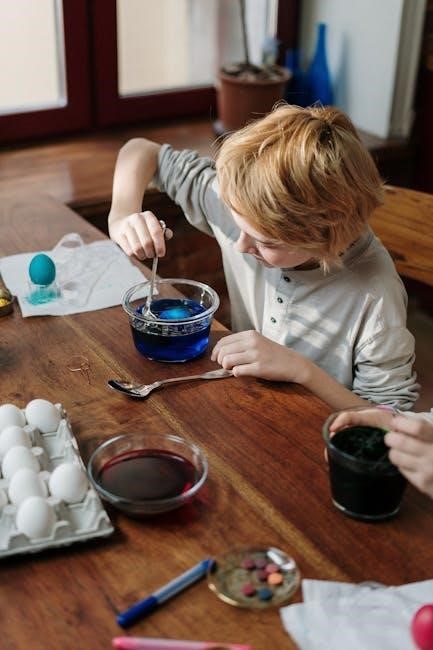
Basics of Color Theory
Color theory explores how colors interact and influence each other. It involves understanding primary and secondary hues, the color wheel, and principles like harmony and contrast. These fundamentals guide effective color mixing, enabling the creation of balanced and visually appealing designs.
2.1 Primary and Secondary Colors
Primary colors—red, blue, and yellow—are the foundation of color theory. They cannot be created by mixing other colors together. Secondary colors, including orange, green, and violet, are formed by mixing two primary colors. For example, red and blue create purple, while blue and yellow make green. This basic understanding is essential for creating color mixing charts, as it forms the starting point for predicting how colors will interact. By mastering primary and secondary hues, artists and designers can build a solid framework for exploring more complex color combinations. These colors are fundamental to both additive and subtractive color models, making them a critical starting point for anyone working with color. Understanding their relationships is key to effective color mixing and design.
2.2 Color Wheel Explained
The color wheel is a circular diagram that visually represents the organization of colors. It is divided into primary colors (red, blue, and yellow) and secondary colors (orange, green, and violet), with tertiary colors (yellow-green, blue-green, etc.) in between. The wheel is arranged so that colors directly opposite each other are complementary, creating the strongest contrast. This tool is essential for understanding color harmony, as it illustrates how colors relate to one another. By using the color wheel, artists and designers can predict how colors will mix and interact. It also helps in identifying warm and cool colors, which is crucial for creating balanced compositions. The color wheel is a fundamental resource for anyone working with color, making it a key component of color mixing charts and design planning. Its visual structure simplifies complex color relationships.
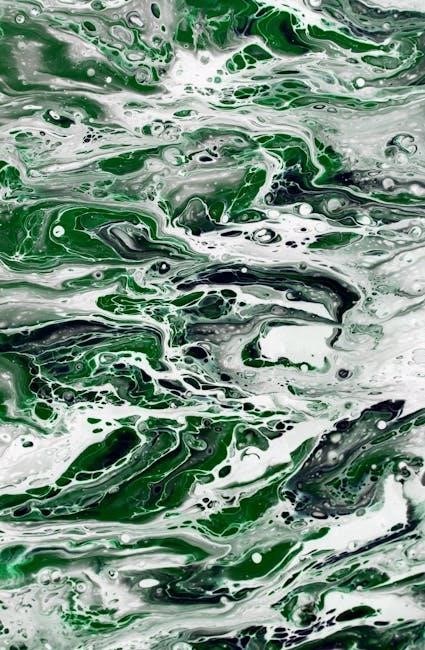
Types of Color Mixing
Color mixing involves combining colors to create new hues. It is categorized into various types based on how colors are blended. Understanding these types is essential for achieving desired effects in art and design.
3.1 Additive vs. Subtractive Color Mixing
Additive and subtractive color mixing are two fundamental approaches to creating colors. Additive mixing involves combining light rather than pigments. It starts with black (no light) and adds colors like red, green, and blue (RGB) to produce a wide range of hues, ultimately reaching white when all colors are combined. This method is commonly used in digital displays, such as screens and LEDs. On the other hand, subtractive mixing works with physical materials like paints or inks. It begins with white (full reflection of light) and subtracts wavelengths as colors are mixed, resulting in darker shades. The combination of cyan, magenta, and yellow (CMY) is a classic example, often used in printing. Understanding these differences is crucial for achieving accurate color results in various mediums.
The Science Behind Color Mixing
The science behind color mixing involves understanding how wavelengths of light interact and pigments combine to produce various hues, essential for creating accurate color mixing charts.
4.1 How Pigments Interact
When pigments are mixed, they absorb and reflect light in complex ways, creating new colors. This interaction is fundamental to subtractive color mixing, where combining pigments reduces the wavelengths of light reflected. Pigments absorb certain wavelengths and reflect others, and their interaction determines the final hue. For example, mixing red and blue pigments absorbs more light, producing a darker, richer purple. The type of pigment, its particle size, and the medium (like paint or ink) influence the result. Understanding pigment interaction is crucial for creating accurate color mixing charts, as it predicts how colors will blend; This knowledge helps artists and designers achieve desired shades and avoid unexpected outcomes. By studying pigment behavior, one can master color mixing and unlock creative possibilities in art and design.
4.2 Understanding Color Models
Color models are systems used to create and reproduce colors accurately. The most common models include RGB (Red, Green, Blue), CMYK (Cyan, Magenta, Yellow, Key/Black), and PMS (Pantone Matching System). RGB is used for digital displays, while CMYK is standard for printing. PMS provides precise, pre-mixed ink colors for consistent results. Understanding these models is essential for predicting color outcomes in various mediums. Color models determine how pigments or light combine to produce specific hues, ensuring consistency across devices and materials. By aligning color choices with the appropriate model, designers and artists can achieve desired results. This understanding is vital for creating reliable color mixing charts, as it bridges the gap between digital and physical color representation, ensuring accuracy and visual harmony in both artistic and professional applications.
Practical Applications of Color Mixing Charts
Color mixing charts are invaluable in art, design, and interior spaces, aiding in palette creation, pigment selection, and achieving desired visual effects like harmony and contrast.
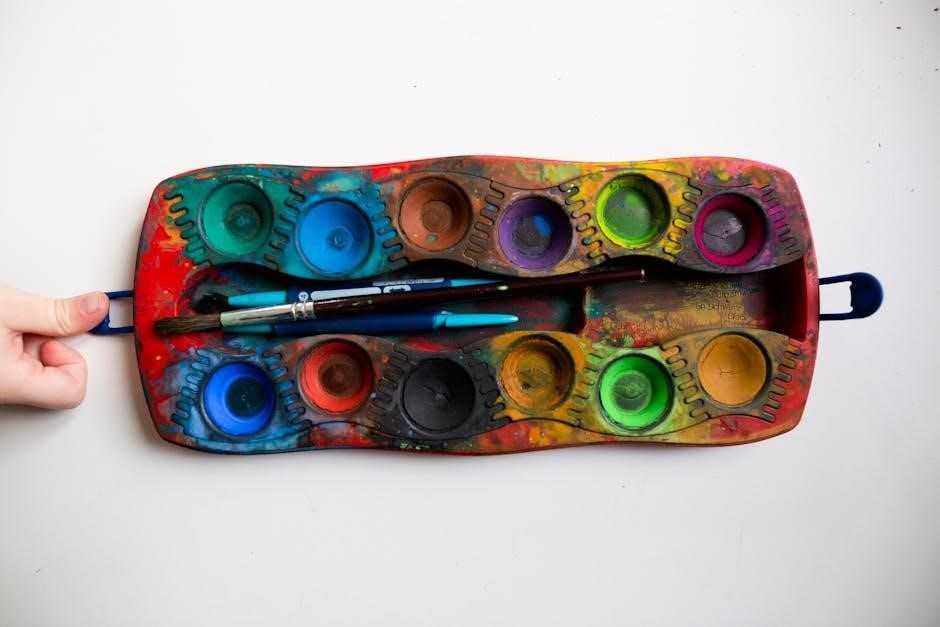
5.1 In Art Education
Color mixing charts are essential tools in art education, helping students understand the fundamentals of color theory. They provide a visual guide for learning how primary colors combine to create secondary colors and how hues can be mixed to achieve specific shades and tones. By using these charts, educators can demonstrate the basics of color harmony, contrast, and the color wheel. Students can experiment with mixing pigments, inks, or paints to see firsthand how colors interact. This hands-on approach enhances learning and creativity, making complex concepts more accessible. Additionally, these charts encourage exploration of color relationships, enabling students to develop practical skills in palette creation and artistic expression. They are particularly useful for teaching children and beginners, bridging the gap between theory and application effectively.
5.2 In Graphic Design
Color mixing charts are invaluable in graphic design, enabling designers to create harmonious and visually appealing color schemes. They help in selecting complementary colors, Understanding color contrast, and ensuring consistency across digital and printed materials. By referencing these charts, designers can predict how colors will appear when combined, ensuring brand cohesion and aesthetic appeal. Tools like Adobe Color and online color mixers utilize such charts to simplify the process of creating custom palettes. Additionally, color mixing charts aid in understanding color psychology, helping designers evoke specific emotions through their work. They are also essential for maintaining color accuracy when transitioning between different design mediums, ensuring that the final output aligns with the intended visual identity. This makes them a cornerstone in both digital and traditional graphic design workflows.
5.3 In Interior Design
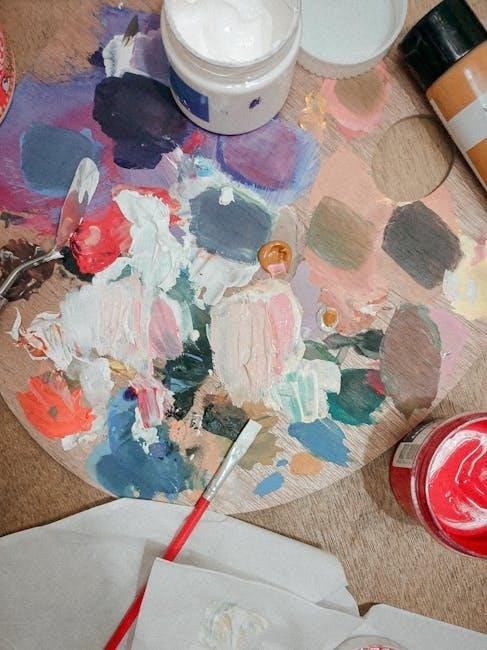
Color mixing charts are essential tools in interior design, helping professionals create cohesive and visually stunning spaces. They enable designers to select complementary colors, ensuring harmony and balance in room aesthetics. By understanding how colors interact, interior designers can guide clients in choosing paint, fabrics, and furniture that align with desired moods or themes. These charts also aid in applying principles like the 60-30-10 rule, which distributes colors to create equilibrium. They simplify the process of matching existing colors with new elements, ensuring a seamless look. Additionally, color mixing charts help in experimenting with shades to enhance natural light effects or create illusions of space; This practical application makes them indispensable for crafting beautiful and functional living environments tailored to individual preferences and architectural styles.
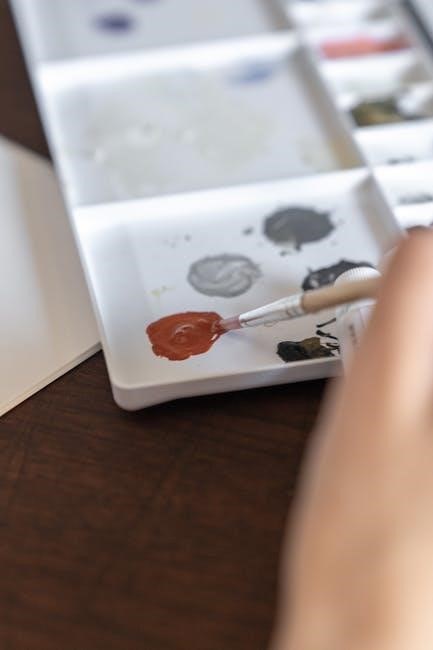
Creating a Color Mixing Chart
A color mixing chart is a visual guide that organizes colors and their combinations, aiding in understanding color theory principles and practical applications effectively.
6.1 Tools and Software
Creating a color mixing chart requires the right tools and software to ensure accuracy and visual appeal. Popular options include Adobe Photoshop and Illustrator, which offer advanced color mixing features and customizable palettes. Inkscape, a free alternative, provides similar functionalities for designing charts. Procreate is another excellent choice for digital artists, featuring intuitive color blending tools. Additionally, online platforms like Canva and ColorPick allow users to create and edit color mixing charts with ease. These tools often include pre-designed templates, color wheels, and gradient options, making the process efficient. Whether you’re a professional designer or a hobbyist, leveraging these tools can help produce a precise and visually engaging color mixing chart tailored to your needs.
6.2 Designing for Clarity
Designing a color mixing chart for clarity is essential to ensure it is user-friendly and effective. Start with a clean layout, organizing colors in a logical sequence, such as a gradient or wheel arrangement. Use high-contrast labels for color names and ratios to enhance readability. Avoid clutter by grouping similar shades and ensuring ample white space. Consistency in font size and style is crucial for a professional look. Consider adding a legend or key to explain the color mixing ratios and codes. For digital charts, ensure the design is responsive and scalable for various devices. Balancing aesthetics with functionality guarantees the chart is both visually appealing and practical. These design principles help users quickly identify and mix colors, making the chart a valuable resource for artistic and design projects.
6.3 Digital vs. Physical Charts
When creating a color mixing chart, deciding between digital and physical formats is crucial. Digital charts offer flexibility and accessibility, as they can be easily shared, edited, and viewed on multiple devices. They are ideal for quick reference and updates, making them a popular choice for designers and educators. Physical charts, on the other hand, provide a tactile experience and precise color representation, which is beneficial for artists and students who prefer hands-on learning. Digital charts can include interactive features like color pickers and mix simulations, while physical charts often serve as durable, long-lasting tools. Both formats have their advantages, and the choice depends on the user’s needs and preferences. Balancing convenience and practicality ensures the chart remains a valuable resource for color mixing tasks.
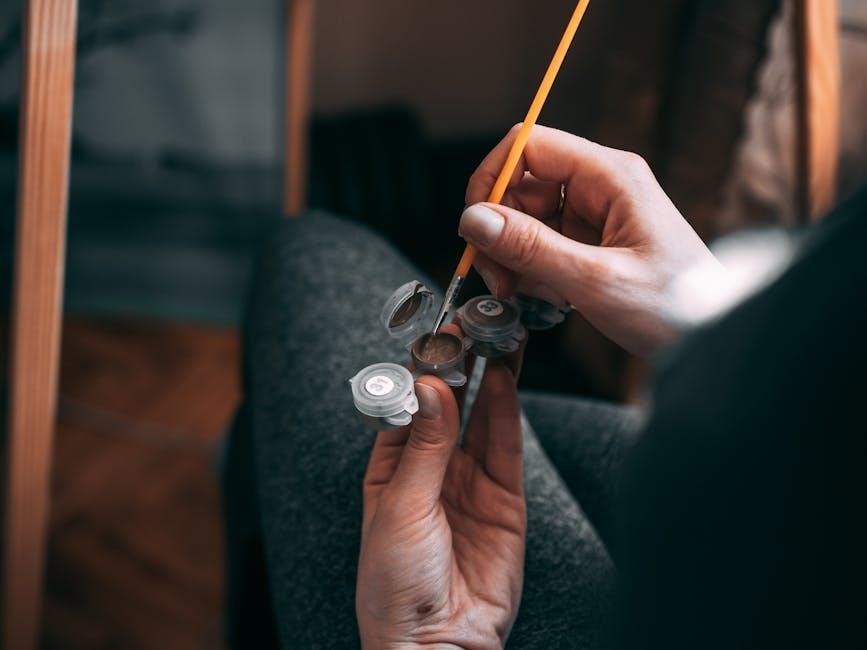
Tips for Effective Color Mixing
Start with primary colors, gradually mix to create secondary hues, and always test small amounts to ensure desired results. Reference a color mixing chart for accuracy.
7.1 Starting with Basics
Mastering color mixing begins with understanding primary colors: red, blue, and yellow. These cannot be created from other hues and form the foundation of all color combinations. Start by mixing two primary colors to create secondary colors—orange, green, and purple. Use a color mixing chart to visualize these relationships. Begin with small quantities to avoid waste and gradually build up your desired shade. Practice creating tints, tones, and shades by adding white, gray, or black. Familiarize yourself with the color wheel to see how colors interact. Always refer to a color mixing chart for guidance, ensuring consistency and accuracy in your mixes. This foundational approach will help you confidently explore more complex techniques;
7.2 Experimentation and Practice
Experimentation is key to mastering color mixing. Start by creating small test batches to observe how colors interact. Use a color mixing chart as a guide, but don’t be afraid to venture beyond its boundaries. Practice mixing primary colors in different ratios to achieve unique hues. Document your results to track progress and identify patterns. Over time, you’ll develop an intuition for predicting outcomes. Explore how adding tints, tones, or shades can expand your palette. Regular practice helps refine your skills, ensuring consistent results. For digital work, use software tools to simulate mixes before applying them physically. This hands-on approach, combined with reference charts, will enhance your understanding of color relationships and improve your overall technique.
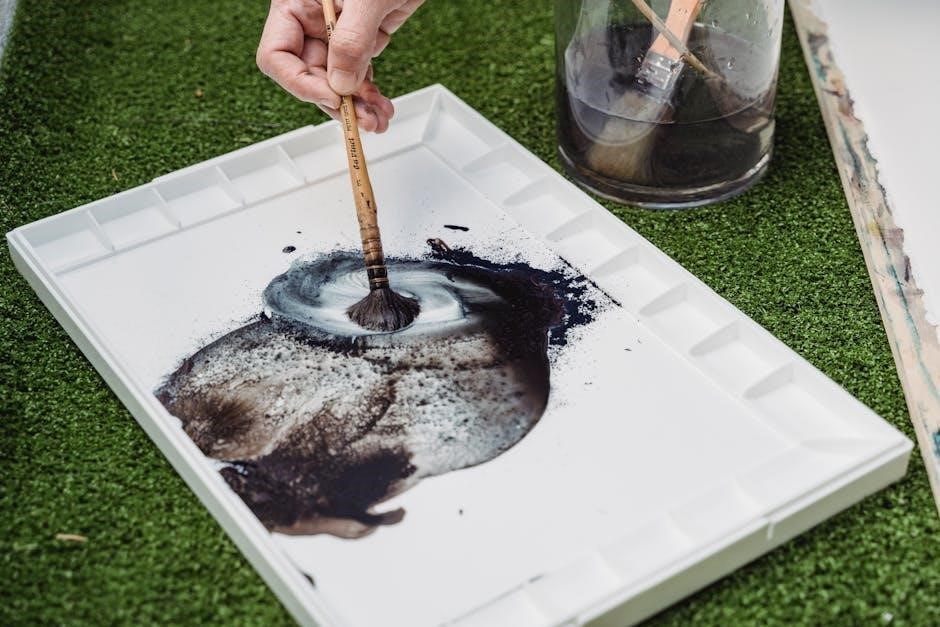
Common Mistakes in Color Mixing
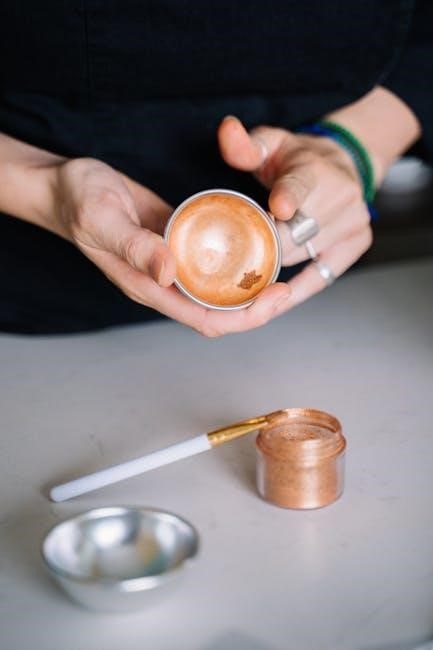
One of the most common mistakes in color mixing is neglecting the basics of color theory, such as the 60-30-10 rule for balanced color schemes. Many individuals overlook the importance of starting with a limited palette, leading to overly complex mixes. Another error is failing to account for the subtleties of pigment interaction, which can result in unintended hues. Overmixing is a frequent issue, as it can lead to muddy or unappealing colors. Additionally, not testing colors under different lighting conditions can cause surprises in the final outcome. Lastly, some forget to document their mixes, making it difficult to replicate results. Avoiding these mistakes requires patience, attention to detail, and a solid understanding of color principles. By learning from these errors, you can refine your technique and achieve consistent, professional-quality results.
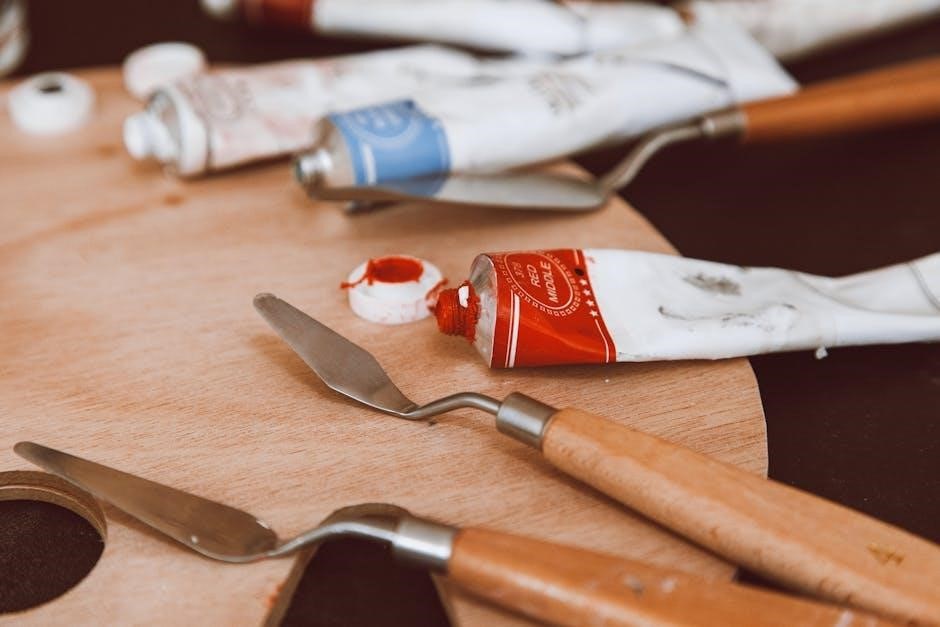
Additional Resources
For further exploration and practical application, numerous resources are available to enhance your understanding of color mixing charts. Websites like Canva and Adobe Color offer downloadable color mixing chart PDFs tailored for various needs. Additionally, platforms such as Pinterest and Behance showcase creative examples of color mixing charts. For detailed guides, consider checking out Color Matters or The Art of Color, which provide comprehensive insights. Many art supply websites also offer printable color mixing charts specifically designed for painters and designers. Lastly, educational institutions often share free PDF resources online, catering to both beginners and professionals. Explore these resources to refine your color mixing skills and stay inspired by diverse creative approaches. Remember, practice and experimentation are key to mastering color mixing effectively.